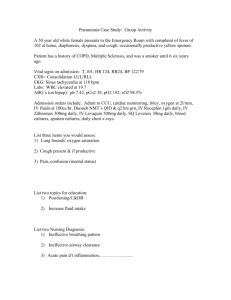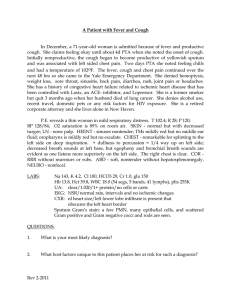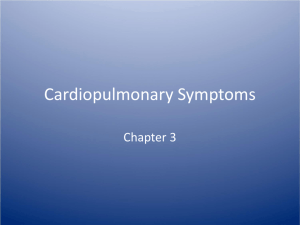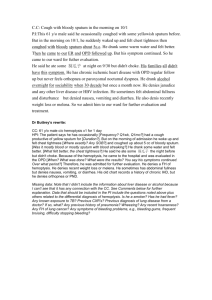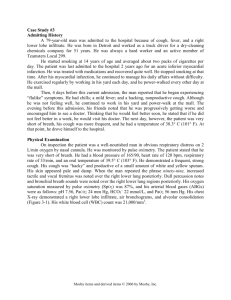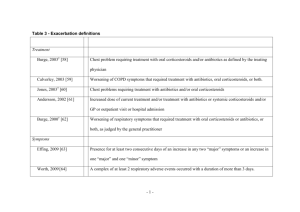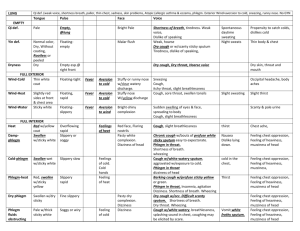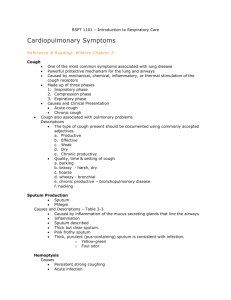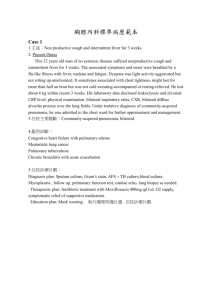诊断学理论双语教案E13
advertisement
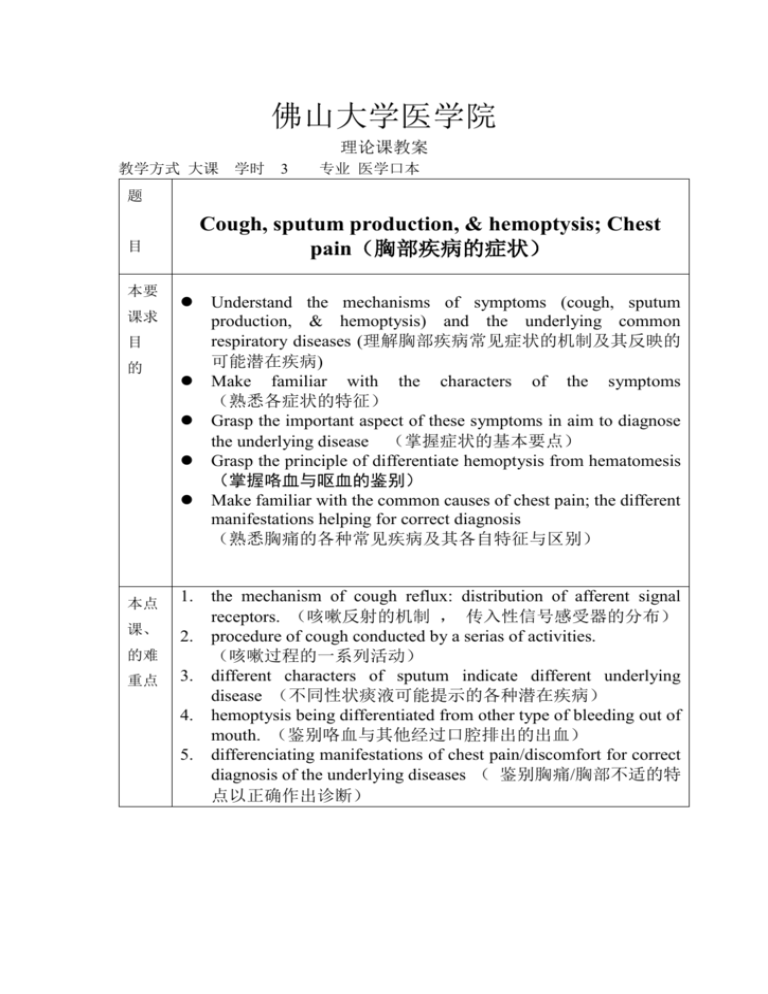
佛山大学医学院 理论课教案 教学方式 大课 学时 3 专业 医学口本 题 Cough, sputum production, & hemoptysis; Chest pain(胸部疾病的症状) 目 本要 课求 目 的 本点 课、 1. 2. 的难 重点 3. 4. 5. Understand the mechanisms of symptoms (cough, sputum production, & hemoptysis) and the underlying common respiratory diseases (理解胸部疾病常见症状的机制及其反映的 可能潜在疾病) Make familiar with the characters of the symptoms (熟悉各症状的特征) Grasp the important aspect of these symptoms in aim to diagnose the underlying disease (掌握症状的基本要点) Grasp the principle of differentiate hemoptysis from hematomesis (掌握咯血与呕血的鉴别) Make familiar with the common causes of chest pain; the different manifestations helping for correct diagnosis (熟悉胸痛的各种常见疾病及其各自特征与区别) the mechanism of cough reflux: distribution of afferent signal receptors. (咳嗽反射的机制 , 传入性信号感受器的分布) procedure of cough conducted by a serias of activities. (咳嗽过程的一系列活动) different characters of sputum indicate different underlying disease (不同性状痰液可能提示的各种潜在疾病) hemoptysis being differentiated from other type of bleeding out of mouth. (鉴别咯血与其他经过口腔排出的出血) differenciating manifestations of chest pain/discomfort for correct diagnosis of the underlying diseases ( 鉴别胸痛/胸部不适的特 点以正确作出诊断) 本材 课及 使参 用考 教书 诊断学------高等医药院校教材 内科疾病诊断与鉴别诊断 problems in pulmonary medicine for the primary physician. By Roberth. Poe, M.D. Lea & Febiger. Philadelphia, 1982. Chest 2006; 129 supplement 本用电 次教化 电脑 CAI 技术 课具器 应及材 Cogh is the most common of respiratory 3 min. symptoms, occurring with a wide variety of diseases that affect the respiratory tract. It is a protective reflux, its present usually 3 min. implies an underlying abnormality of respiratory system or other systems such as cardiovascular. The reflux arc: irritating signals; afferent nerve, 6min. cough center; efferent information to the effect position: glottis, muscles; A series of activities producing high airflow to bring out materials from airway or evaporates the irritation Affecting factors 3 min any factor that interrupt the steps will decrease the cleaning effects of a cough, anesthesia and suppressive drugs, failed closure of the glottis Common causes: inflammatory respiratory 10 min. diseases; neoplasms; Mechanical and chemical irritations; cardiovascular abnormalities; pleural and chest wall diseases. General diseases affecting the respiratory system.; and less seen in emotional reasons. Clinical features: time characters; voice, 10 min. provoking factors; productive or nonproductive; special accompanying appearance. Investigation: general condition(gender, age, 5 min. smoker or not, vocation, hobby or special material approach history); time characters; voice, provoking factors; productive or nonproductive; special accompanying appearance. Selective physical examination in purpose of 3 min. making out the diagnosis. Sputum production 3 min. Causes : miscellaneous infections or accompanying lung paranchymal necrosis. 5 min. Clinical features: feature Volume Laboratory examinations 8 min. Hemoptysis Definition: bleeding of the lower respiratory tract(under glottis level) is cough out termed hemoptysis. Causes: inflammatory disease, immuno-related diseases; cardiovascular abnormalities; congenital diseases; neoplasms. Calcify: Small: Morderate Massive Clinical feature: sputum with blood thread, blood-tinged sputum, mainly sputum or mainly blood mixture, gross blood, welling bleed, intermittent, persistent hemoptysis, or as severe as cause apnea or near-apnea. 3 min. 4 min 4 min 4 min. 5 min Risk aspect is apnea due to blood blocks occlude the airway, rather than that hematomesis leading to blood-loss shock. Clinical evaluation Differentiate from hematomesis Differentiate from upper airway bleeding Concept and common causes of chest pain 5 min. 4 min. 3 min. 7 min Clinical features of chest pain of different 9 min underlying diseases Diferenciation 5 min Review & summary 8 min. 及 小复 结习 要思 点考 题 1. Cough reflux: type of irritating signals and distribution of afferent irritating receptors; efferent information triggering cough activity. 2. How to instruct the patient to cough more effectively to get out respiratory tract secreasion. 3. According to the present character of sputum, how to conduct our diagnosis procedure. 4. Massive hemoptysis and hematomesis are both severe clinical conditions, How to differentiate them as quickly as possible in order to treat them properly.? 5. review the present knolege in combination with those being learnt earlier to prompt your understanding of them. 下及 次后 课续 预课 习程 范介 围绍 撰写人 孟红旗 教研室 诊断学 撰写日期 2008 年
